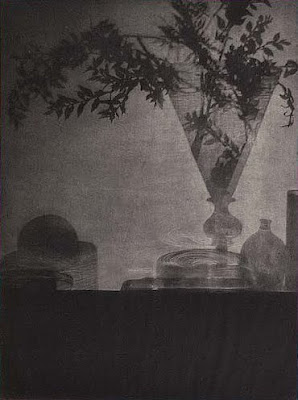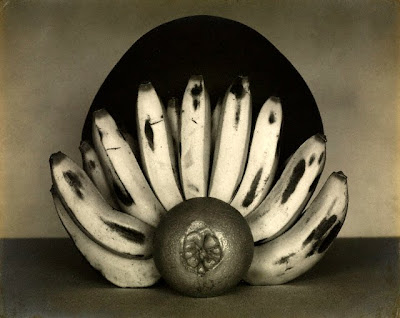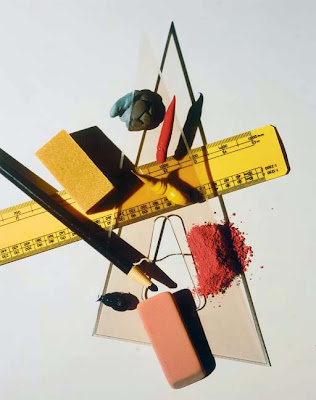For next class, make 12+ images of your chosen object(s).
Each photo is worth one point for a total of 18+ points.
To make each photo 'different,' change the position of the light and/or object...and the light 'filter.'
THE PAINTING

Ambrosius Bosschaert (1573-1621), Still-Life of Flowers, (1614)

Harmen Steenwyck (1612-1656). Still Life: An Allegory of the Vanities of Human Life. (oil on oak panel, 1640)
A dissection of symbolism and meaning HERE

Jean Baptiste Siméon Chardin. The Brioche. (oil on canvas, 1763)
An overview of Chardin HERE.

Dewdrops on dainty petals, light glancing off precious silverware, candied confectionery in blue and white Chinese porcelain bowls, the soft plumage of a dead songbird, the pale hue of a skull – still lifes have not ceased to exercise their spell upon us to this day with their close-up views of inanimate, yet by no means lifeless objects reproduced with painterly finesse. However, still life painting was anything but a merely aesthetic affair, even if today’s viewer tends to perceive it as such. It reflects not only a feeling of transitoriness and a longing for redemption, but also the pleasure of visually representing exotic trading goods with which Dutch and other merchants made their fortunes.
Since its emancipation from the religious painting of the late Middle Ages, when objects mainly served as symbols or attributes, still lifes initially provided a means of understanding and interpreting things from the viewer’s everyday world that were lying still. These objects reflected the order and structure of the Baroque era’s superior abstract world: the human senses or a certain temperament, the elements or the seasons informing the individual’s world, or transitoriness and guilty mankind’s need of redemption.
With the artists’ concentration on a few, often the same objects, still life painting gradually also turned in an ideal field of experimentation for their possibilities of expression. Painterly issues of representation became more important than the originally so prominent contents many works were charged with without ever replacing them entirely. It was above all in still life painting which held a low position in the hierarchy of genre categories that the artist had to prove his specific skills and a work’s attraction and value depended on its composition and ingenious assemblage of objects, its convincing coloring and masterly brushstroke. The paintings also evidence the expertise in rendering the most different materials and surfaces in a manner that deceives the eye. The artists experimented with various kinds of lighting from the even brightness of daylight to the weak glow of a single candle, utilizing them for the mise-en-scène of manifold situations and moods.

Margareta Haverman (Dutch, active by 1715, died in or after 1723). A Vase of Flowers, 1716. Oil on wood
Several female artists of the Netherlands specialized in flower pictures, the best known being Rachel Ruysch (1664–1750). Despite his secretive nature, Jan van Huysum accepted Haverman as his pupil in Amsterdam. She moved to Paris (about 1720?), married an architect, and in 1722 became a member of the Académie Royale. A year later, she was expelled because her reception piece was claimed to be by van Huysum himself. The only other known work by Haverman is a signed but undated flower piece in Copenhagen.

Luis Egidio Meléndez (or Menéndez) (Spanish, 1716–1780). The Afternoon Meal (La Merienda), ca. 1771. Oil on canvas
More about Melendez HERE.

Vincent Van Gogh. Still Life: Vase with Roses. Oil on canvas. Saint-Rémy: May, 1890

Juan Gris (1887-1927). Still Life with Open Window, Rue Ravignan. (oil on canvas, 1915)
A survey of Gris HERE.

Henri Matisse. The Goldfish. (oil on canvas, 1912)
An overview of Matisse HERE.

Giorgio Morandi (1890-1964). Still Life with Cups and Boxes. (oil on canvas, 1951)
More about Morandi HERE.

Zao Wou-Ki. 1951

Andy Warhol. ca. 1960's

Roy Lichtenstein. Still Life with Glass and Peeled Lemon. 1972
Artists to investigate: Willem van Aelst, Pieter Aertsen, Abraham van Beyeren, Peter Binoit, Jan Brueghel d. Ä., Jan Brueghel d. J., Jean Siméon Chardin, Adriaen Coorte, Georg Flegel, Jan Fyt, Willem Claesz. Heda, Jan Davidsz. de Heem, Cornelis de Heem, David Cornelisz. de Heem, Hans Holbein d. J., Justus Juncker, Willem Kalf, Jan van Kessel, Simon Luttichuys, Jacob Marrel, Abraham Mignon, Pieter de Ring, Ludger tom Ring d. J., Rachel Ruysch, Isaak Soreau, Peter Soreau, Harmen Steenwijck, Sebastian Stoskopff, Jan van de Velde, Jacob van Walscapelle, Gottfried von Wedig, and Jan Weenix.
THE PHOTOGRAPH

Armand-Pierre Séguier (French, 1803 – 1876). ‘Still Life with Plaster Casts’. 1839 – 1842. Daguerreotype 8 x 6 in.
“Still life photography has served as both a conventional and an experimental form during periods of significant aesthetic and technological change,” said Paul Martineau, assistant curator, Department of Photographs, the J. Paul Getty Museum, and curator of the a Getty exhibition celebrating the photographic still life. “One of our goals for the exhibition was to show how still life photographs can be both traditional and surprising.”
With its roots in antiquity, the term “still life” is derived from the Dutch word stilleven, coined during the 17th century, when painted examples enjoyed immense popularity throughout Europe. The impetus for a new term came as artists created compositions of increasing complexity, bringing together a greater variety of objects to communicate allegorical meanings. Still life featured prominently in the early experiments of the pioneers of the photographic medium and, more than 170+ years later, it continues to be a significant motif for contemporary photographers.

Charles Aubry (French, 1811 – 1877). [An Arrangement of Tobacco Leaves and Grass]. about 1864. Albumen silver print

Baron Adolf De Meyer (American, 1868 – 1949). ‘Glass and Shadows’. 1905. Photogravure

Paul Strand (American, 1890 – 1976). [Black Bottle]. negative about 1919; print 1923 – 1939. Gelatin silver, on Cykora paper print


Albert Renger Patzsch. Flatirons for Shoe Manufacture. 1926./ Glasses. 1927. Gelatin silver print
Renger-Patzsch achieved in his renderings of objects and the material world. As a protagonist of the movement that came to be known as Neue Sachlichkeit (New Objectivity), he wanted to record, phenomenologically as it were, the exact appearance of objects—their form, material, and surface. Thus he rejected any kind of artistic claim for himself. Believing that the photographer should strive to capture the "essence of the object," he called for documentation rather than art.

Edward Weston (American, 1886 – 1958). ‘Bananas and Orange’. April 1927. Gelatin silver print

André Kertész (American, born Hungary, 1894 – 1985). [Bowl with Sugar Cubes]. 1928. Gelatin silver print
For Bowl with Sugar Cubes, photographer André Kertész created a still life out of a simple bowl, spoon, and sugar cubes, demonstrating the photographer’s interest in the compositional possibilities of layering basic geometric forms on top of one another – three rectangles in a circle (sugar cubes and bowl) and a circle in a square (bowl and the cropped printing paper). A visual sophistication is achieved through his adroit (definition) use of simple objects and dramatic lighting.


Edward Weston. Pepper. 1930

Frederick Sommer (American, born Italy, 1905 – 1999). ‘The Anatomy of a Chicken’. 1939. Gelatin silver print
Influenced by Surrealism, Sommer embraced unexpected juxtapositions and literary allusions to express his intellectual and philosophical ideas. In Anatomy of a Chicken, a severed head, three sunken eyes, and eviscerated organs glisten on a white board. Evoking biblical imagery, medieval grotesques, and heraldic emblems, Sommer calls on the viewer to consider the endless cycle of birth and death, the cruel reality of the food chain, and man’s role in this violence.

Man Ray (Emmanuel Radnitzky) (American, 1890 – 1976). ‘Dead Leaf’. 1942. Gelatin silver print



Andy Warhol. Polaroid Still lifes. ca. 1960/70's

Irving Penn. ‘Still Life with Triangle and Red Eraser, New York, 1985′. dye-bleach print.

Marian Drew (Australian, born 1960). ‘Lorikeet with Green Cloth’. 2006. Digital pigment print
Marian Drew's site HERE. (Check out her other work too!)
Let's buy some of her photos HERE.


Jo Ann Callis. Her website HERE.
.





Cakes 2003, ©Sharon Core

Sharon Core (American). ‘Early American – Still Life with Steak’. 2008. Chromogenic print
Sharon Core, a 1998 Yale MFA grad, sprang into the art world’s consciousness with her 2004 show at Bellwether Gallery, “Thiebauds”. A photographic re-creation of the artist Wayne Thiebaud’s famous food paintings, Core reversed the conventional practice of paintings copying photographs by painstakingly baking, coloring, arranging, and lighting her re-creations and then printing them the same size as the Thiebaud originals.
Four years on and now showing at Yancey Richardson, Core has found new inspiration in the 19th century still life paintings of Raphaelle Peale. Unlike the Thiebauds, however, this time Core has not copied specific paintings. Instead she has analyzed Peale’s work in terms of subject matter, composition, coloration, lighting, and scale in order to understand exactly how they are made and then proceeded to create her own new works in an act of art historical homage.
It’s a difficult feat to pull off, but Core has succeeded where many others have failed, primarily by the softness of her lighting and her mastery of 19th century composition and perspective. As Core fully understands, if you’re going to go for it, you’ve got to go all the way.
Is it a painting or a photograph? Vintage or contemporary? Real or fake? One thing is for certain — these works are undoubtedly beautiful. In her latest series, “Early American,” the photographer Sharon Core explores the works of the American still-life painter Raphaelle Peale (1774-1825). In order to create these old-master-style images, Core used fruit that she grew in her own greenhouse (which she refurbished at her house in upstate New York) and authentic period porcelain and tableware that she collected. (From "In Focus" NYTimes)
A site for Sharon Core's work HERE
A great article on Core's work, and her process/history HERE.
STILL LIFE IN THE STUDIO



TIPS
-Choose your subjects carefully. Make sure they have emotional value for you, then think about it aesthetically.
-Use symbolism to connect and create relationships between objects.
-How do you want to present your objects? (ie. in a box, on fabric, what color is the background, etc.)
-Keep backgrounds as simple as possible...or not.
-Use a tripod, or put the camera on a surface/rice bag/etc.
FURTHER (GREAT!) READING




THE OBJECT AS HERO.
For hundreds of years, artists have made paintings of arrangements of bowls of fruit, food and drink, flowers and musical instruments. The term 'still life' was coined to describe these paintings of inanimate objects. Photographers' first attempts at still life mirrored these compositions. Although the French call a still life 'nature morte', which literally means 'dead nature', the photographer wants to bring the objects to life.
Great still-life photographs can give us a deeper understanding of, and new relationships with, the things that surround us. They focus in on the qualities of an object. Unlike other forms of photography, still life offers photographers a subject that can be totally controlled, particularly in the studio. Lighting, cameras, lenses, and focus are chosen to help find or enhance the beauty of objects.
To give an object a beautiful visual value, a still-life photographer requires strong ideas and an attention to detail. Still life images created for magazines and advertising make objects look heroic. The photographer accentuates, through light and shadow, an object's qualities to capture it at its most luxurious, appetizing, refreshing or fashionable.
Some objects, such as plants, pebbles and shells, are naturally beautiful and have been the subject of many photographic still life photographers. Man Ray, Nick Knight, Robert Maplepthorpe and Andre Kertesz all photographed flowers, amplifying their beauty in different ways. Man Ray solarized his prints of lilies to show flowers ablaze with light. Nick Knight photographed specimens from the flower and plant collections at the Natural History Museum in London on vivid white backgrounds to accentuate their shapes. Robert Mapplethorpe photographed lilies in the studio to show their sensuality, while Andre Kertesz photographed a 'melancholic tulip' distorted like a cubist painting.
Food is a frequent subject of still life. Irving Penn - a master still-life photographer - created a beautiful image of frozen vegetables straight from his freezer. His American Summer Still Life features a bottle of Coca-Cola, a stick of chewing gum, a baseball and a hot dog smeared in mustard. Perhaps Penn's greatest still life - an image of great simplicity and humor - is of massive diamonds, worth millions of dollars, pictured as if dripping from a household tap.
Photographers have found beauty in the overlooked, the discarded and the ugly, sometimes coming upon readymade compositions in the street or their travels. Edward Weston photographed a cement worker's glove, crusty with dried cement. Irving Penn created an amazing series of photos of cigarette butts he'd picked up on the street, enlarging them to the size of posters and creating beautiful prints that give each cigarette a strange sculptural elegance. The result is an identity parade of battered butts. Martin Parr even found beauty in the front seat of his car after it had been broken into, taking a still life of the gleaming tiny cubes of smashed windshield glass sparkling like gems.
One wonderful benefit of cameras is that they can capture fleeting moments in an instant with a quick and easy click of a button. Thus, cameras are almost always preferred for sporting events and even a relaxed portrait of a group of friends. They tend to capture images in a less biased way than paintings, although you can manipulate a camera's angle and effects to alter people's perceptions of the subject. Because of the innovations in cameras, photography has quickly become a new, exciting art form.
However, there are ways that you can combine the techniques of painting with the ease of photography. Many people lament the fact that they have an artistic eye, but not a hand that is artistic enough to wield a paintbrush. For these people, still life photography may be the outlet for you. Although still life images seem to be relegated to paintings, you can actually capture the same peace and tranquility in a photograph.
As mentioned above, millions of people have taken advantages of the instantaneous nature of a camera, so it may seem nonsensical to go back to photographing motionless, inanimate objects. However, as with the still life paintings of old, creating the scene for this type of picture requires a creative and discerning eye in order to create an interesting composition.
With still life images, you are not only in charge of the photography itself, but you also must create the setting-including lighting and arrangement. This may sound simple, but consider a few aspects. First, do you want the light to be believable, like it is coming through an open window? Do you want it to only highlight one small part of the still life, or bathe all of the objects in a glow? Do you want the light to be harsh and high contrast? These are just a few of the choices you will make as you set-up and then engage with your subject matter.
